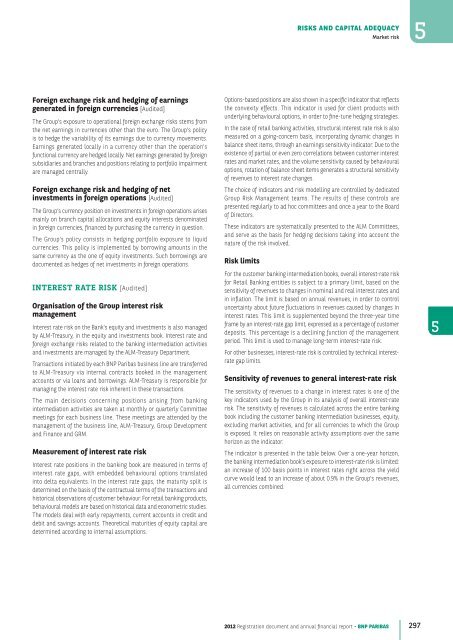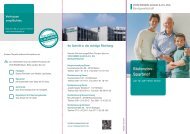2012 Registration document and annual financial report - BNP Paribas
2012 Registration document and annual financial report - BNP Paribas
2012 Registration document and annual financial report - BNP Paribas
- No tags were found...
Create successful ePaper yourself
Turn your PDF publications into a flip-book with our unique Google optimized e-Paper software.
RISKS AND CAPITAL ADEQUACYMarket risk5Foreign exchange risk <strong>and</strong> hedging of earningsgenerated in foreign currencies [A udited]The Group’s exposure to operational foreign exchange risks stems fromthe net earnings in currencies other than the euro. The Group’s policyis to hedge the variability of its earnings due to currency movements.Earnings generated locally in a currency other than the operation’sfunctional currency are hedged locally. Net earnings generated by foreignsubsidiaries <strong>and</strong> branches <strong>and</strong> positions relating to portfolio impairmentare managed centrally.Foreign exchange risk <strong>and</strong> hedging of netinvestments in foreign operations [A udited]The Group’s currency position on investments in foreign operations arisesmainly on branch capital allocations <strong>and</strong> equity interests denominatedin foreign currencies, financed by purchasing the currency in question.The Group’s policy consists in hedging portfolio exposure to liquidcurrencies. This policy is implemented by borrowing amounts in thesame currency as the one of equity investments. Such borrowings are<strong>document</strong>ed as hedges of net investments in foreign operations.INTEREST RATE RISK [A udited]Organisation of the Group interest riskmanagementInterest rate risk on the Bank's equity <strong>and</strong> investments is also managedby ALM-Treasury, in the equity <strong>and</strong> investments book. Interest rate <strong>and</strong>foreign exchange risks related to the banking intermediation activities<strong>and</strong> investments are managed by the ALM-Treasury Department .Transactions initiated by each <strong>BNP</strong> <strong>Paribas</strong> business line are transferredto ALM-Treasury via internal contracts booked in the managementaccounts or via loans <strong>and</strong> borrowings. ALM-Treasury is responsible formanaging the interest rate risk inherent in these transactions.The main decisions concerning positions arising from bankingintermediation activities are taken at monthly or quarterly Committeemeetings for each business line. These meetings are attended by themanagement of the business line, ALM-Treasury, Group Development<strong>and</strong> Finance <strong>and</strong> GRM.Measurement of interest rate riskInterest rate positions in the banking book are measured in terms ofinterest rate gaps, with embedded behavioural options translatedinto delta equivalents. In the interest rate gaps, the maturity split isdetermined on the basis of the contractual terms of the transactions <strong>and</strong>historical observations of customer behaviour. For retail banking products,behavioural models are based on historical data <strong>and</strong> econometric studies.The models deal with early repayments, current accounts in credit <strong>and</strong>debit <strong>and</strong> savings accounts. Theoretical maturities of equity capital aredetermined according to internal assumptions.Options-based positions are also shown in a specific indicator that reflectsthe convexity effects. This indicator is used for client products withunderlying behavioural options, in order to fine-tune hedging strategies.In the case of retail banking activities, structural interest rate risk is alsomeasured on a going-concern basis, incorporating dynamic changes inbalance sheet items, through an earnings sensitivity indicator. Due to theexistence of partial or even zero correlations between customer interestrates <strong>and</strong> market rates, <strong>and</strong> the volume sensitivity caused by behaviouraloptions, rotation of balance sheet items generates a structural sensitivityof revenues to interest rate changes.The choice of indicators <strong>and</strong> risk modelling are controlled by dedicatedGroup Risk Management teams. The results of these controls arepresented regularly to ad hoc committees <strong>and</strong> once a year to the Boardof Directors.These indicators are systematically presented to the ALM Committees,<strong>and</strong> serve as the basis for hedging decisions taking into account thenature of the risk involved.Risk limitsFor the customer banking intermediation books, overall interest-rate riskfor Retail Banking entities is subject to a primary limit, based on thesensitivity of revenues to changes in nominal <strong>and</strong> real interest rates <strong>and</strong>in inflation. The limit is based on <strong>annual</strong> revenues, in order to controluncertainty about future fluctuations in revenues caused by changes ininterest rates. This limit is supplemented beyond the three-year timeframe by an interest-rate gap limit, expressed as a percentage of customerdeposits. This percentage is a declining function of the managementperiod. This limit is used to manage long-term interest-rate risk.For other businesses, interest-rate risk is controlled by technical interestrategap limits.Sensitivity of revenues to general interest-rate riskThe sensitivity of revenues to a change in interest rates is one of thekey indicators used by the Group in its analysis of overall interest-raterisk. The sensitivity of revenues is calculated across the entire bankingbook including the customer banking intermediation businesses, equity,excluding market activities, <strong>and</strong> for all currencies to which the Groupis exposed. It relies on reasonable activity assumptions over the samehorizon as the indicator.The indicator is presented in the table below. Over a one-year horizon,the banking intermediation book’s exposure to interest-rate risk is limited:an increase of 100 basis points in interest rates right across the yieldcurve would lead to an increase of about 0.9% in the Group’s revenues,all currencies combined.5<strong>2012</strong> <strong>Registration</strong> <strong>document</strong> <strong>and</strong> <strong>annual</strong> <strong>financial</strong> <strong>report</strong> - <strong>BNP</strong> PARIBAS 297





